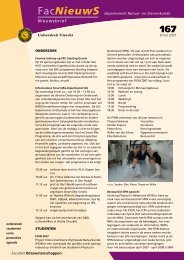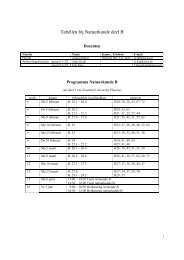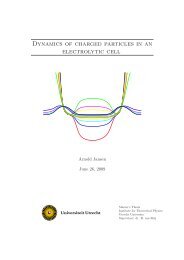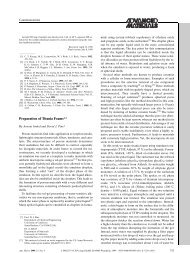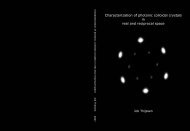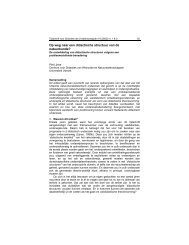Sedimentation Equilibrium of Mixtures of Charged Colloids
Sedimentation Equilibrium of Mixtures of Charged Colloids
Sedimentation Equilibrium of Mixtures of Charged Colloids
Create successful ePaper yourself
Turn your PDF publications into a flip-book with our unique Google optimized e-Paper software.
0.10.08100.06η i 50 5 10 15 200.04i=2X (cm)0.02i=3ρ salt(µM)2015i=100 5 10 15 20X (cm)aE (mV/cm)21.510.50Q/2ρ ssinhφ(x)10 −6−10 −6 00 5 10 15 20X (cm)0 5 10 15 20X (cm)m 3g/Z 3ebm 2g/Z 2em 1g/Z 1eFigure A.2: Density pr<strong>of</strong>iles (a) and the electric field pr<strong>of</strong>ile (b) <strong>of</strong> anequimolar ternary mixture <strong>of</strong> equally-sized colloids with charges Z i =(1000, 250, 125) and gravitational lengths L i = (1, 2, 1)mm with total packingfractions ¯η i = 0.005 in a 20cm ethanol suspension at room temperature,with monovalent ionic strength ρ s = 10µM in the reservoir. Almost completesegregation takes place into well-defined layers <strong>of</strong> pure components, with aslope η i(x) ′ = πρ s σ 3 /3Zi 2 L i and a constant electric field m i g/eZ i in the layerwith component i, as denoted by the dashed lines in (a) and (b), respectively.The inset in (b) shows a dimensionless measure for local charge neutrality(see main text).inset <strong>of</strong> Fig.2(b) shows the ratio <strong>of</strong> the total charge density Q(x) and the ioncharge density 2ρ s sinh φ(x), which is such that |Q(x)/2ρ s sinh φ(x)| ≪ 1 forall x except close to x = 0 and x = H where it is ∼ 1. This indicates that thesystem, with its inhomogeneous electric field, is yet essentially locally chargeneutral (but not exactly, and not at all at the boundaries), suggesting thata description on the basis <strong>of</strong> hydrostatic equilibrium within a local densityapproximation should be rather accurate [17].A.5 Polydisperse <strong>Mixtures</strong>We now extend our study to polydisperse mixtures, where one could expectsegregation into many layers on the basis <strong>of</strong> the results for two and threecomponents. We mimic the polydispersity by considering a system <strong>of</strong> n = 21components, with Z i distributed as a Gaussian with average <strong>of</strong> 250 and astandard deviation <strong>of</strong> 50. This distribution is shown in the inset <strong>of</strong> Fig. 3(a),where the vertical axis (¯η i ) is proportional to the relative frequency <strong>of</strong> speciesi in the sample. We consider two distributions for L i : (A) L i = 2mm for all59



